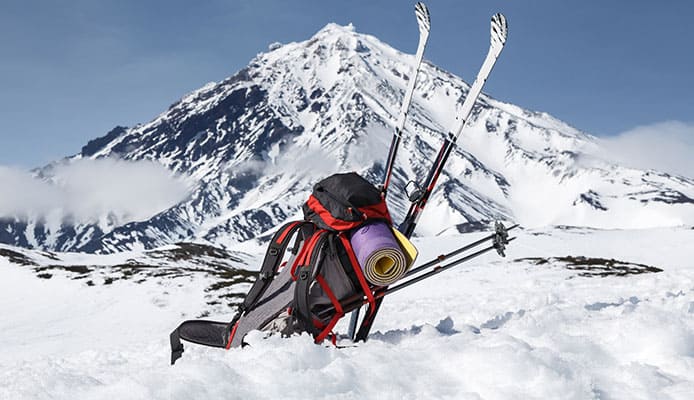
When you’re getting ready to hit the slopes, you take a lot of time choosing the right ski gear. From finding the best jacket to choosing the right boots, it’s an expensive endeavor. So it’s important to make sure that gear is safe. Not to mention, there isn’t anything quite as frustrating as getting ready to hit the slopes after travel only to find that your gear has been damaged en route.
That’s why it’s crucial to research the best ski bag to keep your gear safe. There are plenty of options out there from ski boot bags to ways to carry extra gear like goggles and gloves. To help you out today, we’re going to take a look at some of the best ski bags to keep your skis and poles safe.
OUR TOP PICK
Dakine Fall Line Double
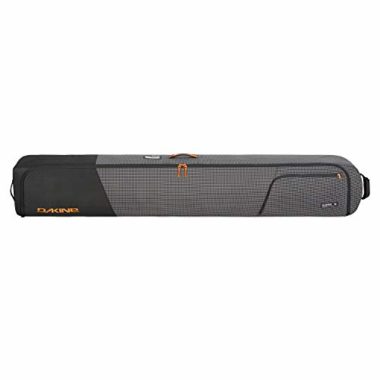
- Stand Out Features - Why We Love It
- Can carry up to two sets of adult skis and one pair of adult ski boots
- 360-degree padding helps to protect skis in transit
- Exterior pockets allow you to carry extra gear like hats and gloves
- Urethane wheels make it easy to roll through an airport
Dimensions: 175 cm – 12” x 8” x 74” (30 x 20 x 188 cm)/ 190 cm – 12” x 8” x 80” (30 x 20 x 203 cm)
Weight: 6.2 lbs (2.8 kg)
Material: 600D polyester
EDITORS CHOICE
High Sierra Combo Boot
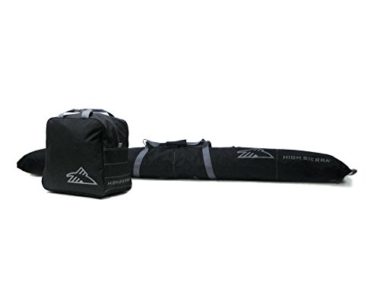
- Stand Out Features - Why We Love It
- Comes as a combo with a ski boot bag
- Holds up to 200 cm skis but the end can be rolled up to secure smaller skis
- Exterior, adjustable compression straps help to keep your skis safe and in place
- Webbed, polyester handles make for easy carrying
- Limited lifetime warranty protects your purchase
Dimensions: Ski bag – 79.5” x 14” x 10” (202 x 35 x 25.4 cm)/ Ski boot bag – 15.25” x 16” x 10” (38.7 x 40.6 x 25.4 cm)
Weight: 3.3 lbs, total
Material: 600D polyester
BEST VALUE
Athletico Two-Piece
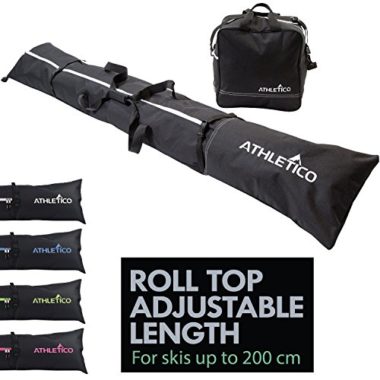
- Stand Out Features - Why We Love It
- Comes as a combo with a ski boot bag
- Can be purchased with colored trim, making it easy to distinguish from other bags during air travel
- Fits up to 200 cm skis but can be rolled and fastened for shorter skis
- Made to store other gear like jackets and helmets as well
Dimensions: Ski bag – 80” x 13.75” (203 x 35 cm)/ Ski boot bag – 15.25” x 16” x 10” (38 x 40 x 25 cm)
Weight: 2.9 lbs, total
Material: 600D polyester
Athletico Diamond Trail Padded
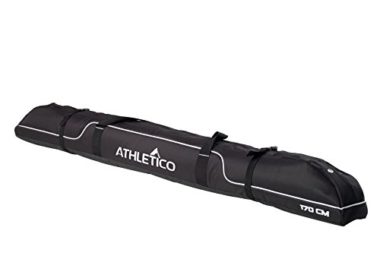
- Stand Out Features - Why We Love It
- Available for skis up to 175 cm and skis up to 185 cm
- Meant for professional-level skiers, so it’s made to last through heavy use
- Exterior compression straps help to lock all your gear into place
- Water-resistant backing keeps your gear dry
- Ventilation grommets help to avoid stale or musty smell the bag might usually retain
- Neoprene padded handles make it easy to carry
- Full, EZ Glide zippers won’t get caught and make it easy to load and unload gear
Dimensions: 185 cm – 75” x 7” x 7” (192 x 18 x 17 cm)/ 170 cm – 70” x 7” x 7” (177 x 18 x 17 cm)
Weight: 2.4 lbs
Material: 600D polyester
Sportube Series 1

- Stand Out Features - Why We Love It
- Hard case design increases durability and keeps your poles and skis safe during travel
- Case slides to fit skis ranging from 122 cm to 212 cm
- Padded ends help to protect your poles and skis
- Rubber wheels help you easily roll the case behind you rather than carry its weight
- Can be lashed to the top of a car while traveling to save space in the trunk
- 5-year warranty protects your purchase
Dimensions: 48” – 81” x 6.6” x 5.5” (18.9 – 205.74 x 16.8 x 14 cm)
Weight: 8 lbs
Material: High-density polyethylene
High Sierra Deluxe Wheeled Double
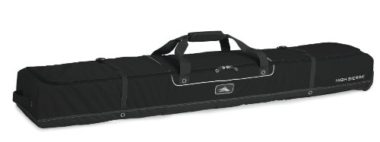
- Stand Out Features - Why We Love It
- Main compartment is divided to hold 2 pairs of skis up to 185 cm at least
- Padding in the compartments helps to protect both pairs of skis
- Exterior compression straps and interior straps add extra security
- Carrying handle is made with neoprene padding for easy carrying
- Rolls on in-line skates for easy transport
Dimensions: 73” x 12” x 7” (185.42 x 30.48 x 17.78 cm)
Weight: 2.55 lbs
Material: 600D Duralite
OutdoorMaster Boot
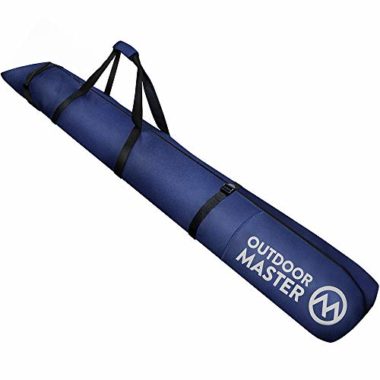
- Stand Out Features - Why We Love It
- Bag can hold skis of up to 200 cm skis but can be rolled down to secure smaller skis
- Includes a matching ski boot bag
- 600D nylon won’t tear or puncture easily
- Water-resistant design means that your gear won’t get soaked on the slopes
- Ergonomic handles make this bag comfortable to carry
- Available in multiple color options
- OutdoorMaster offers a lifetime warranty if you run into any problems with the bag
Dimensions: Ski bag – 78” x 13” (198 x 33 cm)/ Ski boot bag – 15” x 9” x 15” (38 x 23 x 38 cm)
Weight: 2 lbs
Material: 600D water-resistant nylon
Athalon Single Padded
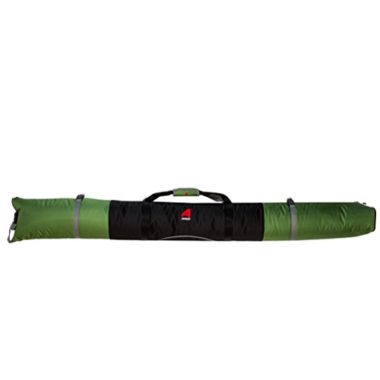
- Stand Out Features - Why We Love It
- Carries a pair of skis as long as 180 cm
- Lightweight bag made with strong polyester that won’t tear or rip
- Waterproof back keeps your skis dry on the slopes
- External compression straps help to lock skis securely into place
- Ergonomic handles make this bag comfortable to carry
- Compact, light design makes this bag useful for staying under airline weight requirements
Dimensions: 75” x 12.5” x 5” (190.5 x 31.75 x 12.7 cm)
Weight: 2.4 lbs
Material: 600D polyester
AmazonBasics Double Padded
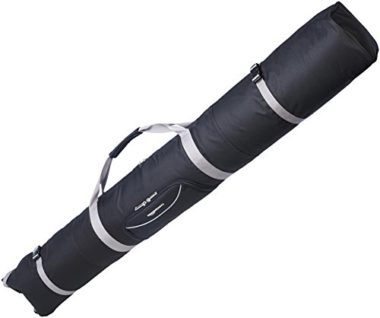
- Stand Out Features - Why We Love It
- This bag is affordable without skimping on the quality
- End-to-end padding and exterior compression straps ensure your skis don’t get too jostled in transit
- Self-repairing nylon-coil zipper won’t catch or break when you need it the most
- 1680D polyester weave makes it one of the most durable options on the market
- Waterproof backing helps to protect your gear in the snow
- Padded grip handles make it easy to carry this bag to and from the slopes
- Exterior zippered pockets help you carry additional gear
- AmazonBasics offers a 1-year limited warranty on this bag if you run into any problems
Dimensions: 59” x 7” x 7” (149.86 x 17.78 x 17.78 cm)
Weight: 2.15 lbs
Material: 1680D polyester
Sportube Series 2 Wheeled Double

- Stand Out Features - Why We Love It
- This large case will hold two pairs of skis ranging from a length of 122 cm to 212 cm
- Hard case will protect your skis from almost anything
- Interior padding on either end of the case protects the ends of your poles and skis
- Wide enough to hold all skis including powder ski with a width of 280 mm
- Inline-style wheels allow you to roll this case rather than carry its weight in your hand
- Has a place for a TSA-approved lock, so you can protect it during air travel
Dimensions: 48” – 83.5” x 11” x 6” (122 – 212 x 28 x 15.2 cm)
Weight: 12 lbs
Material: High-density polyethylene
How To Choose The Best Ski Bag – Buying Guide
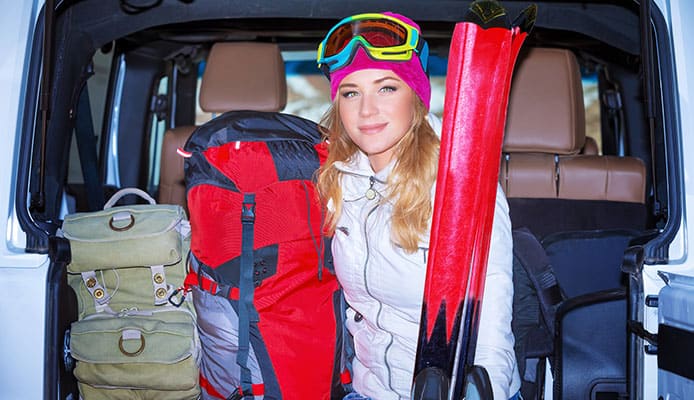
Soft Vs. Hard
Choosing between a soft ski bag or a hard ski bag is, in the end, a point of preference. Each ski bag has its own pros and cons.
Hard cases are going to protect your skis better. A hard case doesn’t have as much give, so it prevents anything from directly pressing on top of your skis. This means that if you’re traveling with a lot of gear and are worried about your skis getting caught up on the bottom of the pile, they’ll be safer in a more durable ski bag.
The downfall of hard cases is that they’re rather bulky. They don’t have the same flexibility as soft ski bags.
Hard cases are typically made from high-density polyethylene or, shortened, HDPE. These are also handy because if you’re taking a drive to the slopes, they can be lashed to a roof rack in a pinch.
It’s also worth noting that soft ski bags don’t sacrifice durability for their give – they’re still going to protect your skis and a quality choice will last you quite a while. The flexible body is also going to be easier to transport thanks to the reduced bulk in weight. This lightweight option can be especially helpful if you need a ski bag for air travel.
When you’re choosing a soft ski bag, you’ll want to pay attention to denier. This refers to how tightly woven the threads are. The higher the number is, the more tightly woven the threads are. You’re going to want to look for a denier of at least 600 with polyester fabric. With that in mind, you’re less likely to run into tears or punctures.
Wheels
You can also purchase a ski bag with wheels. A wheeled ski bag is usually made to carry two or three pairs of skis. The tradeoff for extra space is bulk but the wheels are there to help carry that bulk for you. You carry the ski bag by the front handles while the back end rolls on wheels. So, it’s important to choose a ski bag with sturdy wheels – rubber wheels are best. The wheels should have the same style as a pair of inline skates.
Number of Skis
We already mentioned that wheeled ski bags are typically made to carry two or three sets of skis. If you have multiple sets of skis to carry, you’ll want to pay attention to ski bags that can carry more than one set of skis. This will save you money compared to buying an individual ski bag for everyone. You’ll also want to check to see the size of the skis that it’ll hold. If you’re bringing a pair of adult skis and child skis, you might not need as big of a bag. The manufacturer should specify the number of skis the bag can hold as well as the size of the ski bag.
Ski Length and Weight
Of course, you’ll want to make sure you purchase a ski bag that’s sized to fit your needs. To make sure you find the right ski bag, you’ll need to take the length and width of your ski into account. Skis and ski bags are typically measured in centimeters, so you’ll want to convert them from inches if you use the American system. You can manually do this by multiplying the number of inches by 2.54 but it’s much easier to simply use an online inches-to-centimeters conversion tool.
Remember that ski bags aren’t made to stress, so you’ll want to be careful in your measurements. Most ski bags are made with different ski sizes in mind but if you’re worried about the fit for your skis, it’s better to get a ski bag that’s a little big rather than too small.
Another answer to size worries is adjustable bags. Adjustable ski bags are available in both soft and hard cases. Still, you’ll want to check the minimum and maximum bag lengths.
If you’re also looking for a ski bag with the potential to carry your snowboard, you aren’t going to want to purchase something narrow. The best choice is to pick up a bag meant to hold multiple pairs of skis.
You might also like: Top Gifts For Skiers And Snowboarders
Color
Color, at the end of the day, comes down to personal preference. If you choose darker colors like black, you’re going to see less dirt and grime build up on your ski bag. Unfortunately, a standard black bag might easily get lost on a flight when it’s stored with several other ski bags.
There are two ways around this. For one, you could get a uniquely colored ski bag. Alternatively, you could use bright tape to mark the shoulder strap of your ski bag to easily set it apart from other similar ski bags.
Straps
Most ski bags will have nylon exterior and interior straps. The interior straps are used to hold your skis and poles in place. This adds extra security against the skis and ski poles getting damaged from jostling around.
Exterior straps are compression straps meant to prevent gear from rubbing and clashing against other gear. High-quality ski bags tend to have both interior and exterior straps but ski bags made to cater towards lower budgets don’t typically include them.
Additional Features
There are plenty of additional features you can opt for when you’re choosing a ski bag. The main feature that most people look for is extra storage. Some ski bags have additional pockets to hold ski gear like hats, gloves, socks, neck gaiters, and even probes, beacons, and shovels. The pockets don’t always provide enough protection for goggles but you can wrap them in a hat or cloth to keep them safe.
You can also look for features that can help you transport your skis. Handles will make carrying your ski bag easier. With soft-sided ski bags, you can expect a strap made with nylon webbing. Most hard-sided ski bags include plastic handles in their design. Higher-end bags might have padded handles to help with lifting. Wheeled ski bags usually have this feature as well.
If you don’t want to carry your ski bag in your hand, you’ll want to look for ski bags with a shoulder strap. These are usually included on soft-sided ski bags and options with padded shoulder straps are going to be more comfortable to carry.
Padding
When it comes to protecting your skis, you’re going to want to consider a ski bag with padding. This helps to keep your skis and poles from jostling around too much and it can help add extra protection from other objects pressing against a soft case ski bag.
If your ski bag doesn’t have protection, a tip that many uses are to pack clothes in the bag around the skis. This helps to add an extra layer of protection during a car or air travel.
FAQs
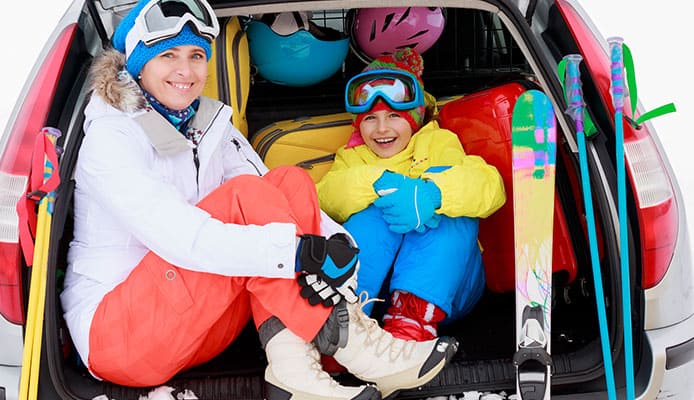
Q: Flying with skis: what are the rules?
The specific rules for flying with skis can vary from airline to airline. Generally, you’re going to need a ski bag for flying like the ones we’ve looked at here because almost no airline is going to allow you to check loose skis.
There are two basic situations depending on the airline. First, an airline may allow you to check the ski bag just like you would any other luggage. They may count the ski bag and a ski boot bag as a single piece of luggage. The amount you have to pay for a checked bag can vary but some airlines allow you to have one or two bags checked without an extra fee.
The second option is checking your skis as sports equipment. This happens when the airline doesn’t accept your skis as standard luggage. If this is the case, you’ll need to pay for a sports equipment fee. This is usually around $50 to $60. For instance, Ryanair charges a ski equipment fee that will let you carry your ski equipment as long as it meets the 20 kg or about 44 lb requirement. The airline charges you 50 EUR – about $56.95 USD – if you pay after booking or once you get to the airport. You’ll have an easier time if you check your ski equipment earlier during booking. This also helps you save since it cuts the cost down to 45 EUR or about $51.26 USD.
Since we’ve mentioned that airline to airline policy differences, let’s take a moment to consider some of the major airlines.
American Airlines allows skiers to check a boot bag with boots, live preserver, and helmet as well as skis up to 126 inches as a single piece of luggage. However, if the boot bag is more than 45 inches or holds anything that isn’t specified in the list above, you’ll need to pay an excess fee.
British Airways, on the other hand, ski bags can be counted as regular luggage. If it weighs more than their allowance or exceeds 75” x 29.5” x 25.5” or 190 cm x 75 cm x 65 cm.
If you have a bag with skis and poles as well as a ski boot bag, Delta Airlines will allow you to count it as one piece of luggage. This is free unless the combined weight doesn’t break the 50-pound limit. If it does, you’ll need to pay an excess baggage fee.
JetBlue has a unique policy in which you don’t have to worry about size limits but overweight fees still apply. All of your ski equipment has to be stored with the right ski bags or they won’t be counted as part of your equipment but rather just as luggage.
Southwest Airlines allows you to split your skis, poles, and boots even if you need to split them up between two bags. If they’re packed into the proper bags, they count as part of your regular luggage but you don’t have to worry about oversize fees but overweight fees still apply.
Lufthansa allows you to check your ski bag normally which is free as your first checked bag unless you’re flying Economy Class Light. Since only the first ski bag is free, it’s a good idea to look for a ski bag big enough to store extra items such as boots and clothes. They don’t have a size restriction but there are fees for overweight baggage. Their limit is 32 kg or approximately 70.5 lbs.
Some airlines don’t have specific rules for skis outlined on their website. Spirit Airlines is an example of this. If you’re flying with them, it’s a good idea to call ahead and inquire how to fly with your skis.
Q: How to pack skis for air travel?
Since skiing equipment can be easy to damage while at the same time it can damage your other luggage, you’ll want to pack your skis right before traveling. The last thing anyone wants to do is add to the cost of air travel with damaged luggage or skis.
The first rule of traveling with skis is to pack them in an airline ski bag. Skis shouldn’t be thrown into just any ski bag that will fit them. Top-rated ski bags are made to fit and protect your skis specifically, so they’re the best choice when you’re getting ready to travel. Not to mention, most airlines won’t allow you to travel with skis unless they’re properly stored.
The biggest thing to concern yourself with after that point is ensuring that your ski bag meets any weight limits an airline might have. If you’re worried about meeting weight requirements, a soft ski bag is comparatively lighter than a hard ski case. If it’s allowed, pack some clothes around the skis for extra padding. You should also put covers over the ends of your poles to prevent them from damaging any other luggage you might be carrying.
Finally, you’re going to want to make sure you label your ski bag properly just like any other piece of luggage to make sure everything stays in the right hands. This means grabbing a luggage tag and putting your name, phone number, and even address to get them back if they get lost in transit.
It’s also a good idea to pick up a luggage lock to make sure no one can unlock your ski bag aside from security and you. Just make sure the lock you use is TSA-approved before heading to the airport.
Q: Can I fit extra gear in my ski or snowboard bag?
This depends on the snowboard and ski bag you choose. Some are made to just hold skis while others are made to be more all-encompassing options. These usually hold smaller pieces of ski gear like gloves, hats, goggles, and clothes. Most bags don’t come with a specialized pocket for goggles. To combat this, many wrap their goggles in their hat and store them together. This will keep your goggles from getting scratched.
There are also some ski bags that come as part of a “combo deal” in which you get another travel item. Usually, the pairing is a ski bag and a ski boot bag.
Globo Surf Overview
Having a ski bag will help to make sure that your skis and poles get to the slope safely. You have plenty of options in sizes and styles. Picking up one of the ski bags will help you safely transport your skis to and from the slopes no matter how long that journey is.
More Snow Ski Gear Reviews:
- Ski Pants
- Cross Country Ski Gloves
- Skiing Books
- Backcountry Ski Bindings
- Women Ski Boots
- Cross Country Ski Boots
- Women’s Skis
- Watches For Skiing
- Ski And Snowboard Tuning Vises
- Ski And Snowboard Wall Racks
- Kids Ski Helmets
- Ski Gloves For Kids
- Photochromic Ski Goggles
- Ski Boots For Kids
- Kids Ski Poles
- Ski Boots For Narrow Feet

